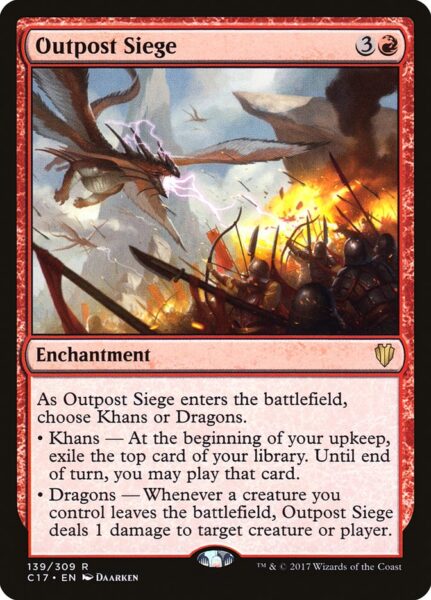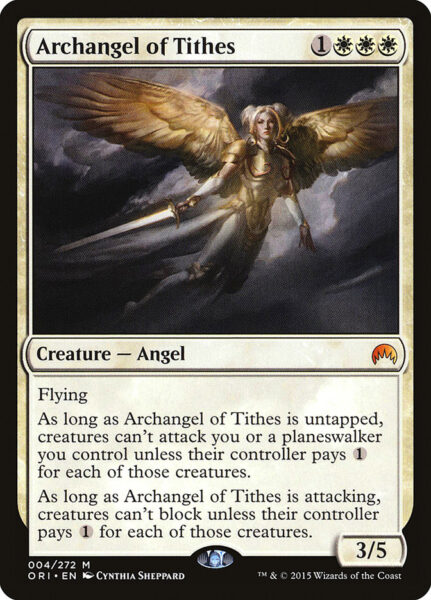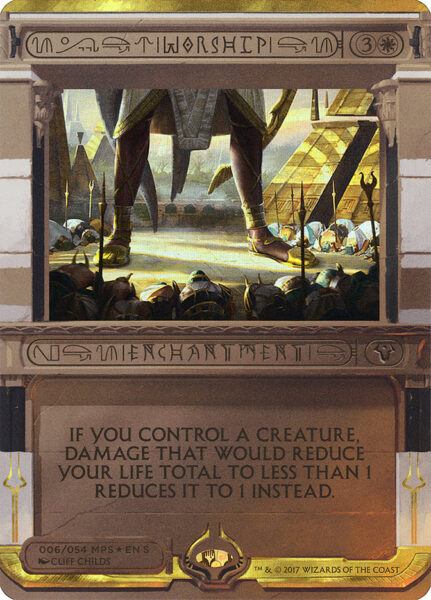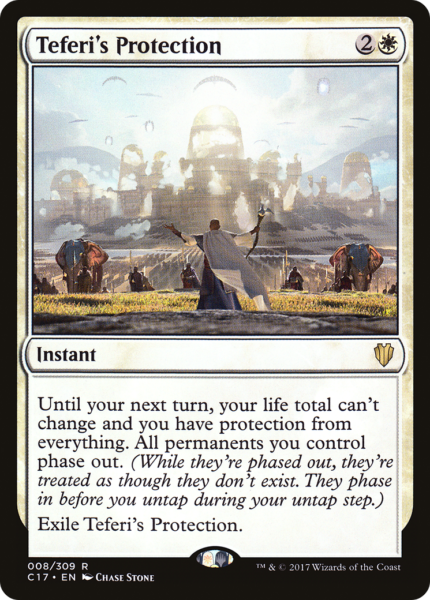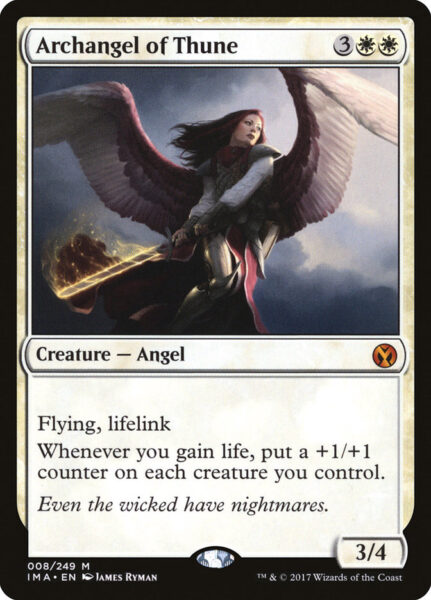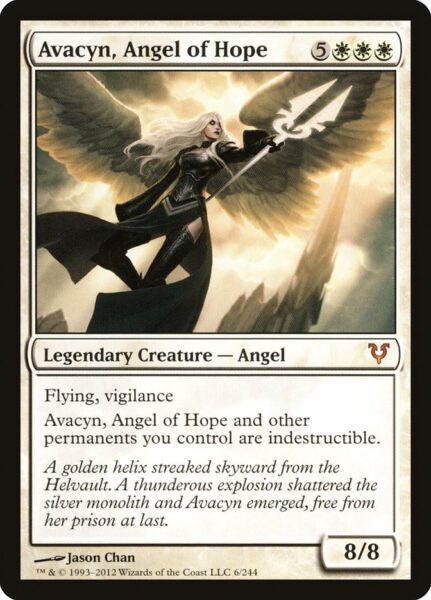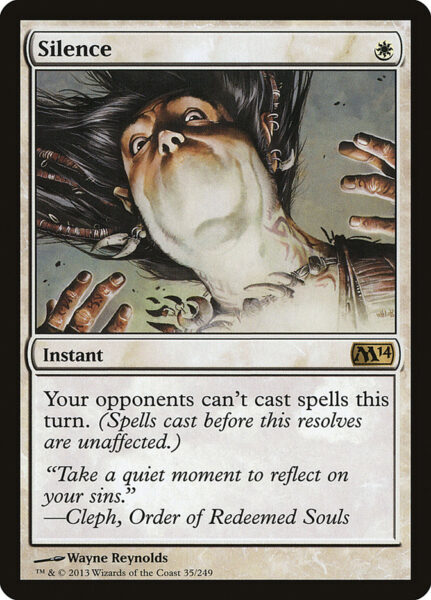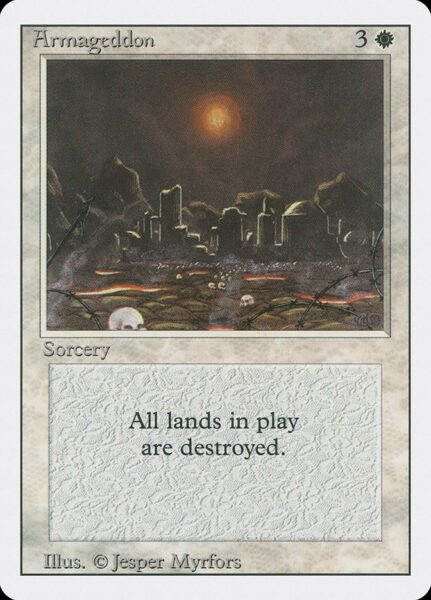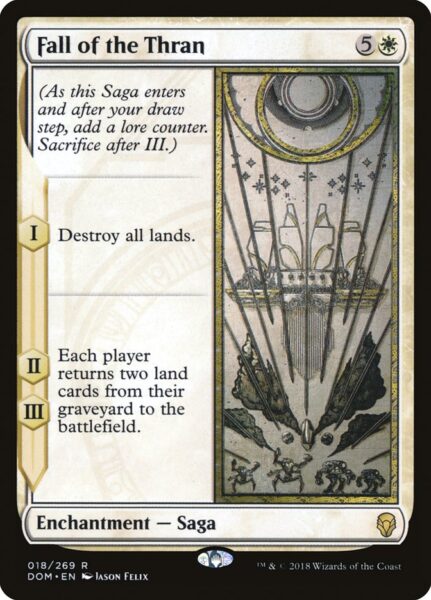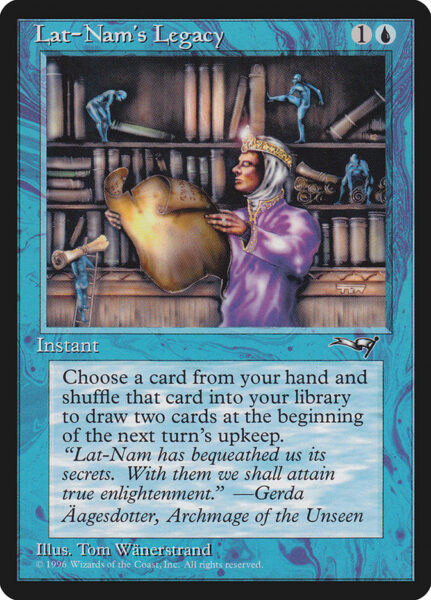
Want to lock opponents out of playing their strategy? Enjoy solving puzzles? Love angels? This is the deck for you! Prison decks are known for preventing opponents from playing Magic, and this deck is no exception. Find the right answers and revel in your opponent’s increasing levels of salt. However, be warned! Find the wrong answers and lose with a bunch of underpowered and unimpressive creatures…it’s life on the Prison edge!
Decklist – Mono White Prison with Heliod, Sun-Crowned
| Heliod, Sun-Crowned |
Creatures (32) with 1 mfdc
| Esper Sentinel | |
| Giver of Runes | |
| Mother of Runes | |
| Archivist of Oghma | |
| Containment Priest | |
| Drannith Magistrate | |
| Ethersworn Canonist | |
| Hushbringer | |
| Imposing Sovereign |
| Avacyn, Angel of Hope |
Planeswalkers (1)
| Elspeth, Sun’s Champion |
Artifacts (12) with 1 mfdc
| Jeweled Lotus | |
| Mox Amber | |
| Grafdigger’s Cage | |
| Pithing Needle | |
| Shadowspear | |
| Cursed Totem | |
| Pearl Medallion | |
| Crawlspace | |
| Damping Matrix |
| The One Ring | |
| Valkmira, Protector’s Shield (mfdc) | |
| Norn’s Annex |
Enchantments (12)
| Authority of the Consuls | |
| Deafening Silence | |
| Land Tax | |
| Ashes of the Abhorrent | |
| Blind Obedience | |
| Rest in Peace | |
| Runed Halo | |
| Aura of Silence | |
| Tocasia’s Welcome | |
| Smothering Tithe | |
| War of the Last Alliance | |
| Worship |
Instants (2)
| Flawless Maneuver | |
| Teferi’s Protection |
Sorceries (5) with 2 mfdcs
| Winds of Abandon | |
| Day of Judgment | |
| Farewell | |
| Emeria’s Call (mfdc) | |
| Ondu Inversion (mfdc) |
Lands (38) with 2 mfdcs
| War Room |
| Plains (25) |
Primary Game Plan
Unlike many Heliod, Sun-Crowned decks, we aren’t trying to go infinite with Walking Ballista or completely abuse the life gain. Instead, we are looking to lock our opponents out of whatever their strategy is via a wide range of hate cards. The life gain built in the deck primarily gives us the time to find all of our pieces. Once we have the correct pieces in place to prevent our opponent from doing what they want, we fly over with a bunch of powerful angels to close out the game. More than other decks I’ve played, this one feels like a giant puzzle with many moving parts. Our goal is to find the right parts at the right time.

Yes, this is one half of a 2-card, I-win combo…No, we aren’t playing it.
I’ll discuss which cards could (and maybe should) have a home in this deck in a later section, but if you read over the decklist and immediately asked, why no Walking Ballista, it’s because my playgroup avoids 2-card combos that end the game on the spot. I, personally, also don’t really want to play with or against 2-card combos when one of the needed combo pieces is the commander. This guarantees access to half of the necessary combo, which, in turn, incentivizes us to build a deck that maximizes our chances of finding the other piece. That style of deckbuilding and gameplay gets repetitive and stale fairly quickly and is the chief reason I no longer have my very first Commander deck, which, if you haven’t guessed yet, was a dragon deck, helmed by Scion of the Ur-Dragon.
Games I won with this deck almost always ended the same.
For more about my Commander philosophy, read this. Now, tangent aside, let’s get back to Mono White Prison with Heliod, Sun-Crowned!
Hate Cards
In a 100-card format that is looking to lock opponents out of certain strategies, redundancy is important. Given that White lacks true tutors, it is even more important. Such redundancy has its drawbacks, as we can draw all of a single type of hate card and not the others, but we want to maximize our chances of having the right answer at the right time. Furthermore, given that our commander wants to give creatures lifelink and then grow them, we have put a primacy on hate cards that are creatures. I’ll discuss other directions for this deck at the end.
Enter-the-Battlefield (ETB) Effects
Creatures with ETBs are immensely popular and extremely powerful, as they offer an immediate 2-for-1. Many commanders and the decks built around them look to abuse ETBs to their maximum with cards like Panharmonicon , Yarok, the Desecrated, or my mono-red deck, Purphoros, Bronze-Blooded, which you can read about here.
Elesh Norn, Mother of Machines – a new addition, Mom is our most powerful creature among the four that shut down ETBs, giving us a hate piece and a potential finisher. Her doubling of our own ETBs will rarely be relevant, but it can’t hurt.
Hushbringer – this card does so much in the deck, shutting down both ETB and death triggers, while synergizing with our life-gain strategy. Its evasion is relevant, as we almost never want to block with our hate pieces and can chip in some damage early if necessary. It may be a 40-turn clock, but at least it synergizes with Heliod, Sun-Crowned and can grow itself if necessary.
Hushwing Gryff – flash adds some flexible gameplay, while its evasion and 2 power is a plus.
Tocatli Honor Guard – a straightforward, no-frills answer, and a great example of the power level of the cards we’re playing in both the right and wrong spots. Opponent looking to abuse Roon of the Hidden Realm? This soldier is a must-answer threat and one of our best draws. Opponent looking to ramp into big bombs or win by storming off? Here’s another 40-turn clock! Welcome to life on the Prison edge!
Graveyard and Library Shenanigans
If your graveyard isn’t a resource, then you better have a good reason. Even we want to recur things from our yard, despite all the hate we have for such strategies. The idea, of course, is that our hate will punish our opponent more and can be deployed when most effective and least painful for us. Playing cards from the top of one’s library is a powerful effect that is appearing on more and more cards of all colors. Shutting down Conspicuous Snoop can be the difference in winning and losing.
Grafdigger’s Cage – a 1-mana, hard-to-answer hate card that targets both the graveyard and the library is great. It only stops creatures, though, so Blue players will still be able to take advantage of cards like Future Sight when they reveal a non-creature card (which will more often than not be very frequently) and Green players will still get to play lands with their Courser of Kruphix. It’s also a tutor target for our Urza’s Saga.
Ashes of the Abhorrent – a new addition that’s replaced Weathered Runestone (for now). This enchantment gets the nod over the more hateful artifact due to the lifegain it gives us. Watch out for the nonbo with our own Rest in Peace.
Containment Priest – an instant-speed gotcha removal spell to answer Collected Company and blink shenanigans at its best. This cleric is great against a surprising number of cards, including Kaalia of the Vast and our own Emeria, the Sky Ruin, so be careful not to play into it yourself.
Drannith Magistrate – perhaps most hated for preventing opponents from casting their commander, this wizard does a whole lot more. It shuts down the aforementioned Future Sight and cards like it that make the top of your deck an extension of your hand (Vizier of the Menagerie, Augur of Autumn with Coven, etc.). Furthermore, casting cards from exile is a powerful form of card advantage that Drannith Magistrate prevents, as well. Chandra, Torch of Defiance and Abbot of Keral Keep are two examples that have seen play across formats, while Wizards continues to print cards with this effect, including Fires of Mount Doom and Decadent Dragon from sets released this year (2023). Drannith Magistrate stops all of these shenanigans.
Reidane, God of the Worthy – someone in your playgroup love playing snow lands just because? Let’s teach them a lesson about having fun!
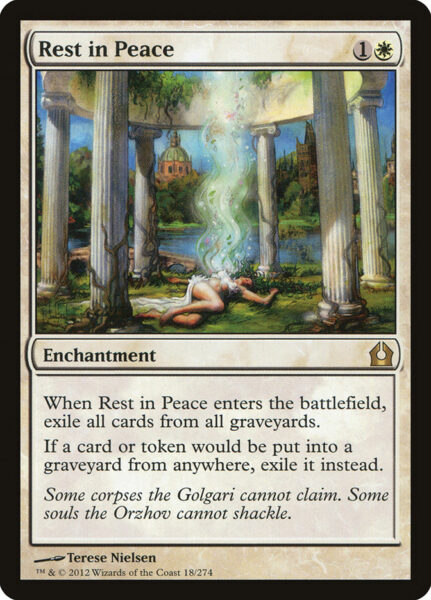
Rest in Peace – White’s premier answer to the graveyard. The second line of text shuts down death triggers, which can be extremely useful. Rakdos Sacrifice trying to burn you out with Blood Artist? I don’t think so.
Tomik, Distinguished Advokist – one of our more narrower hate pieces, Tomik hates on landfall decks like Omnath, Locus of Creation and Lord Windgrace, by shutting down cards like Crucible of Worlds and Life from the Loam. More narrowly, the advisor has the abililty to stop ramp spells that enchant lands, like Utopia Sprawl and Wolfwillow Haven. It also protects our lands from targeted removal, which is nice. That it has flying is both oddly strange and a bonus. One day, I may be able to afford Moat, after all…
Playing on Curve, Hasty Threats, and Blocking
Piloting a Prison deck to victory often comes down to stalling, or buying time, until we can find the right piece against our opponent’s strategy or a finisher to close out the game. We play a variety of ways to slow our opponent down that target lands and creatures. Keeping our opponent off curve can delay a powerful commander from coming down until we find an answer, while making their creatures come into play tapped shuts down hasty threats, at the very least, while negating entire strategies, at the very most (Purphoros, Bronze-Blooded decks, for example).
Authority of the Consuls – no hasty dragons or cheated-in bombs. No immediate activations of Krenko, Mob Boss or Kelsien, the Plague. It also synergizes with our lifegain plan and comes down as early as turn 1, making this one of our all-stars.
Blind Obedience – taps down creatures and artifacts, thus slowing down our opponent’s mana-rock ramp plan. Extort gives us more lifegain synergies, while, in a pinch, an alternate win-con.
Imposing Sovereign – the most vanilla of our options and on a fragile body. Still, sometimes you just need any creature!
Archon of Emeria – a perfect card for our deck, it supports two of our hate strategies, here causing nonbasic lands our opponents control to enter tapped. No shocking that Hallowed Fountain in!
Kinjalli’s Sunwing – for one additional mana, we get a 2/3 flier that causes our opponent’s creatures to enter tapped.
Thalia, Heretic Cathar – hitting nonbasic lands, as well as creatures, makes this one of our most powerful cards in this category. First strike makes her an effective blocker.
We have six cards that cause our opponent’s creatures and/or lands to enter tapped. This may seem like a lot given how many types of hate cards we need to have an answer to all the strategies and threats found in Commander (and we’ll never have all the answers). However, don’t underestimate the power of this effect, or the true annoyance it causes for opponents. Furthermore, given how many cheap creatures we play, sometimes we can win through sheer tempo. Stopping our opponent’s creatures from blocking the turn they enter the battlefield can be the difference in winning and losing.
Taxing Spells
Slowing our opponent down is frequently all we need to give us the time to find the necessary pieces either to protect ourselves indefinitely or to lock them out of what they’re trying to do.
Aura of Silence – against decks that run a lot of artifacts and enchantments, this can really mess with an opponent’s game plan. That it can get rid of whatever ails us if necessary is a huge plus.
Boromir, Warden of the Tower – a new addition replacing Nevermore, it shuts down free spells while doubling as wrath protection. It could be Nevermore is just better, but Boromir is a new, shiny toy that I want to test out. It’s a soldier, too, which synergizes with Myrel, Shield of Argive.
Esper Sentinel – not a true taxing effect, it does punish our opponent for ignoring it by drawing us a card. Get it down on turn 1 and reap the vast rewards this Modern all-star has to offer. Grow it to immense proportions with Heliod, Sun-Crowned and all but guarantee an extra card from it.
Reidane, God of the Worthy – causing opponent’s snow lands to enter tapped isn’t the real reason this god is in the deck. Taxing our opponent’s big noncreature spells is. It’s a modal, double-faced card with a relevant backside for our strategy, making this one of our most powerful cards.
Thalia, Guardian of Thraben – another Modern staple, her effect is universal, which can annoy us as much as our opponent.
Valkmira, Protector’s Shield – the backside of Reidane, God of the Worthy, it’s the second box of text that is relevant here. It’s a Thalia, Guardian of Thraben on steroids that only hurts our opponents.
Drawing Cards
White notoriously lacks card draw, though Wizards is working to change this, so let’s ruin our opponent’s fun!
Smothering Tithe – a Commander all-star, this enchantment doesn’t stop players from drawing extra cards, but it does tax each card or give us a Treasure token.
Spirit of the Labyrinth – the ideal answer to those Blue and Black players looking to draw through their decks.
Casting Spells
We don’t run Mana Tithe or Reprieve, but we can slow our opponent down in other ways, namely by limiting them to a single spell a turn. The chief drawback of these cards is it also limits us to one spell a turn.
Archon of Emeria – limits each player to one spell a turn, while hating on nonbasic lands, all on a 2/3 flier…yes, please! Note also that, unlike some of the other cards in this category, it doesn’t care what type of spell is cast.
Deafening Silence – limits each player to one noncreature spell. It’s an enchantment, which can make it harder for our opponents to deal with than the creatures that fill out this list.
Eidolon of Rhetoric – limits each player to only one spell, regardless of type. Its 4 toughness makes it a capable blocker.
Ethersworn Canonist – punishes nonartifact spells only, which may whiff on occasion, but redundancy is key and this is another effect that will often hamstring our opponent right out of the game.

Searching Libraries
From tutors to fetch lands, limiting our opponent’s ability to resolve these effects can be the difference between winning and losing. It is also just annoying to play against, which is essentially the point of a Prison-style deck.
Archivist of Oghma – doesn’t prevent our opponent from searching, but it does reward us with a card and a life.
Aven Mindcensor – its flash ability gives us maximum hate, while limiting our opponent to searching just the top 4 cards of their library.
Leonin Arbiter – sometimes taxing our opponent’s tutors and fetch lands slows them down enough for us to find our lock pieces. We have some of our own tutors, so be careful to play around our own tax.
Activated Abilities
Creatures who do things other than attack and block are the bread and butter of Commander. We’re going to want to put a stop to that.
Pithing Needle – the premier catch-all for a single threat, we can target creatures, Planeswalkers, fetch lands…anything except mana abilities. A great answer to problem commanders and it’s tutorable with Urza’s Saga!
Cursed Totem – for the low cost of 2 mana, we nerf ALL activated abilities of creatures. Let the weeping of the Llanowar, Fyndhorn, and Mystic Elves commence!
Damping Matrix – shuts down all creatures and artifacts, unless they’re mana abilities. One might think most activated abilities of artifacts are mana abilities, but some of the most efficient answers to what we’re doing come in the form of artifacts such as Oblivion Stone and the like. Note that this card is a nonbo with our commander’s activated ability.
Linvala, Keeper of Silence – our best, if not most fragile, hate card against decks looking to combo or ramp with creatures. The evasion and 3/4 body, plus its synergies with our other angels, make this a good draw, even when the rest of the text doesn’t matter.
Myrel, Shield of Argive – a new addition I’m testing out, this card protects us from instants (Counterspell who?), as well as prevents our opponents from activating their artifacts, creatures, and enchantments…but only on our turn. It replaced Defense Grid, which also hurts us. We play 6 soldiers and Elspeth, Sun’s Champion, who makes Soldier tokens, so the second box of text is not irrelevant either. Note, as well, that the Soldier tokens Myrel, Shield of Argive make are artifacts, meaning they will grow our Urza’s Saga Constructs, as well. The synergies!
Noncombat Damage
While the majority of decks are looking to win via creature damage, there are enough commanders out there that incentivize our opponents to win with instants and sorceries that the following cards are worth including. Furthermore, even creature-based decks will frequently have a back-up plan that involves targeting us with spells to win the game (we’re looking at you, Mono Red Goblins!).
Metropolis Reformer – a new addition replacing Leyline of Sanctity, this angel is exactly what we want for this kind of effect. It has evasion, unlike Aegis of the Gods, synergizes with our angels and lifegain substrategy, and is a creature we can grow with our commander.
Runed Halo – sometimes we just have to find a way to stop all those Keranos, God of Storms triggers from bolting us out of the game. Other times, it can stop us from dying to commander damage or to a gigantic Fireball. Adding 2 to our devotion on a difficult-to-answer card is a bonus.
The One Ring – yes, I’ve mentioned how I don’t want to jam this into every deck just because I can, but that’s not what’s happening here. White needs card draw and a mono-white Prison deck needs it even more, as we will often be digging for answers while teetering on the edge of death. The lifegain built into our strategy ameliorates the drawback (is it really, though?) of the life we pay for the cards we draw. Buying us a turn when it enters the battlefield can be all the time we need. If you’ve been playing Modern since Lord of the Rings was released, you know all these things already. If you haven’t, well, The One Ring is a busted, busted card.
Valkmira, Protector’s Shield – the other side of Reidane, God of the Worthy, this artifact shuts down Kelsien, the Plague plus deathtouch shenanigans at its best, while saving us some life and taxing our opponent’s spells and abilities targeting us or our permanents. Take that Liliana of the Veil‘s -2!
Combat Damage
With noncombat damage limited or nullified, we turn our attention to preventing combat damage, the primary means of dying in a Commander game.
Archangel of Tithes – taxing each of our opponent’s attacking creatures will often stop him or her from swinging in with enough to 1-shot us. She also makes blocking a pain for our opponents, while synergizing with our angel synergies.
Crawlspace – a new addition replacing Ensnaring Bridge, we can still die from combat damage, but limiting the number of creatures who can attack us will slow things down and – say it with me – sometimes that’s all we need to find the right piece to ensure our victory. Ensnaring Bridge is great at keeping us alive, but it’s also great at stopping us from turning the corner and attacking.
Norn’s Annex – a powerful card that doesn’t see enough play, in my opinion. We can cast it as early as turn 3 and, while our opponent can attack through it, there’s a good chance this will come at the cost of their life total.
Worship – a card that has underwhelmed me in the past, I think it is worth the inclusion here for a variety of reasons. First, our commander will frequently be a creature due to the number of enchantments and other noncreature permanents we control. Given Heliod, Sun-Crowned’s indestructibility, it will be easier for us to keep a creature around through boardwipes. Second, we run a lot of creatures and have both ways to recur them and ways to protect them from targeted removal. Worship, at its worse, will buy us an extra turn while our opponent finds an answer, and, as is the theme with this deck, time is what we need most to find our lock pieces.
Protection for Our Hate Cards
Sticking a hate piece is crucial to our gameplan – okay, it is our gameplan – but keeping it around will often mean the difference between winning and losing.
Avacyn, Angel of Hope – our best finisher, the protection she provides keeps our board state intact against all but exile effects.
Emeria’s Call – does a little bit of everything we want: it makes angels that synergize with our finishers, while protecting almost all of our hate pieces until our next turn, while doubling as an untapped land.
Flawless Maneuver – giving our creatures indestructible for free when our opponent thinks they found the answer is as backbreaking as it sounds. This cycle of free spells when you control a commander are at their best with indestructible commanders like ours.
Giver of Runes – can’t protect itself, but can protect any other creature from either the color of our choice or colorless, unlike…
Mother of Runes – who can protect itself from the color of our choice, but not from colorless sources.
Ranger-Captain of Eos – a conditional tutor that buys us a turn of protection against wraths. Sometimes that’s all we need.
Teferi’s Protection – a blowout against Farewell-type effects, it can also keep us alive through combat or direct damage in a pinch.
Lifegain
Its hard to say lifegain is our back-up plan when it synergizes so well with Heliod, Sun-Crowned, so instead we will include it as part of our hate plan. Gaining a bunch of life doesn’t win games, it’s true, but it sure makes it hard for our opponent to kill us. Keeping our life total high is yet another way we are able to buy us the turns we need to find our lock pieces and eventually our own finishers. The benefit of Heliod, Sun-Crowned, of course, is that he can turn any of our creatures into a finisher with enough time.
Archangel of Thune – in competition with Avacyn, Angel of Hope as our best finisher, Archangel of Thune can grow our team incredibly fast, allowing us to close out games in a few short turns.
Archivist of Oghma – there’ll be games where we gain 0 life off this halfling, but I want to test him out.
Ashes of the Abhorrent – unlike Archivist of Oghma, it will be a rare game in which this enchantment doesn’t gain us some life. Unless, of course, we’ve nerfed it ourselves with Rest in Peace. Don’t do that unless absolutely necessary.
Authority of the Consuls – the lifegain is dependent on our opponent, but if they aren’t playing creatures, there’s a good chance we’re already winning.
Blind Obedience – the Extort mechanic turns any of our subsequent spells into 1 life.
Hushbringer – a creature with lifelink. It can come down as early as turn 2 and, when followed by our commander, can immediately start growing itself or another creature. Getting our more fragile hate pieces out of range of Lightning Bolt or Mizzium Mortars is often relevant.
Lyra Dawnbringer – by the time we’re attacking with a bunch of lifelinking angels, we’re usually about to win. However, a single attack with Lyra Dawnbringer in conjunction with Heliod, Sun-Crowned can have a snowball effect and grow our many, many underwhelming creatures into terrifying giants.
Shadowspear – has the added benefit of hating on hexproof and indestructible creatures our opponent controls. Trample is rarely irrelevant and we can tutor it up with Urza’s Saga. No wonder this card hovers around $20.
Removal
If we can’t tax it, let’s just kill it.
Day of Judgment – this should probably be Wrath of God, since it is the better card, but I have a Russian Mystical Archive Day of Judgment. Sometimes you just have to go with your heart.
Elspeth, Sun’s Champion – a conditional board wipe that can also win us the game. She is one of my all-time favorite Planeswalkers and arguably the best 6-mana Walker ever printed.
Farewell – this card can be quite the nonbo with our own strategy, but sometimes exiling our opponent’s problematic permanents at the cost of our own must be done. Plus, we get to play around it and the card is extremely flexible.
Ondu Inversion – a nearly free inclusion in a mono-colored deck, it’s an over-costed boardwipe or a tapped land.
Winds of Abandon – an early answer to a must-kill commander, or a game-winning play late game.
Finishers
If our opponent doesn’t scoop from a broken spirit or a salt overload, we will have to win a different way. Sigh. Combat it is.
Not much more needs to be said about these angels that I haven’t already detailed above. We play a total of 6 angels, meaning we have 5 other angels to synergize with Lyra Dawnbringer. This isn’t an angel deck, so this is definitely a substrategy. One of the above 3 will often be enough to close out a game, assuming we have the right hate pieces in place. And, even if we don’t, sometimes they present a fast enough clock to get there.
Furthermore, Heliod, Sun-Crowned has the ability to turn any single creature into a massive, must-answer, game-ending threat. This is one main reason we play so many creatures as part of our hate package, even though they’re underpowered and more fragile than an enchantment or artifact that has a similar effect. We need targets to grow with our commander’s static ability. The low mana cost and evasion many of these creatures have, coupled with the fact that we really aren’t interested in blocking with our hate pieces, means we will frequently chip in damage early and often against a single opponent. This will put us in position to close out the game quickly once we find a finisher.
The Rest
The rest of the deck consists of ramp, a bit of card draw, and some tutors. Per usual, here more than anywhere is a good place for customization. See Flex Spots for a list of possible cards for the deck.
Jeweled Lotus – allows for extremely powerful opening plays in which we can cast our commander and Esper Sentinel, for instance, and start the game far ahead of our opponent. Really, just casting our commander on turn 1 will put us far ahead, but let’s live the dream!
Knight of the White Orchid – conditional ramp on a body that can attack and block well, particularly if we get a few +1/+1 counters on it.
Land Tax – while technically neither ramp nor card draw, Land Tax ensures we hit our land drops while thinning our deck and increasing our chances of finding action off the top.
Mox Amber – in a deck with an indestructible legendary creature, this seems like an obvious choice. Beware, though, that if Heliod, Sun-Crowned isn’t a creature, it won’t turn on this legendary artifact. We do run 11 other legendary creatures and enchantments, so more often than not this won’t be a dead draw. I could also see cutting it for something more reliable, however.
Pearl Medallion – with its reprinting and lower cost, I finally bought the cost-reducing artifact. Seems like a no brainer in a mono-colored deck.
Ranger-Captain of Eos – we have only 3 targets, but each is impactful in its own way. A case could certainly be made for increasing our 1-drop creature count, Serra Ascendant being an obvious candidate, or cutting the soldier for a hate piece we need more of. However, its main purpose is to protect us against wraths the turn before we want to win.
Tocasia’s Welcome – another recent addition, we run 25 creatures who will trigger this enchantment and draw us a card. Seems pretty deec.
War of the Last Alliance – another new card I’m still testing, we have 11 targets for its first two modes, ranging from hate pieces like Thalia, Guardian of Thraben, and Tomik, Distinguished Advokist, to finishers, like Avacyn, Angel of Hope. It’s third mode might end up doing nothing, but it might also win us the game.
Flex Spots
One easy way to make room for other cards, whether it be removal, card draw, or a favorite card (Brimaz, King of Oreskos anyone?) is to trim a hate piece from the various categories. Redundancy is important in a deck like this, but would going from 5 cards that stop activated abilities of creatures to 4 really make the deck worse? What about one less card that hates on graveyards? I think trimming here and there, particularly to make room for a different form of hate that helps in your own meta, is perfectly fine.
Besides this, there are some creatures that I’ve added recently that I haven’t gotten the chance to test fully, but which seem like cards that could be cut without impacting the overall power level or gameplan of the deck. Without detailed commentary for each, what they have in common is they could be replaced with cards that function similarly (or perhaps better). A card like Archivist of Oghma could easily be replaced by Well of Lost Dreams; Boromir, Warden of the Tower by Void Mirror or Selfless Spirit; and Mox Amber by any number of mana rocks.
| Mox Amber | |
| Archivist of Oghma | |
| Tomik, Distinguished Advokist | |
| Boromir, Warden of the Tower | |
| Kinjalli’s Sunwing | |
| Tocasia’s Welcome | |
| Myrel, Shield of Argive | |
| War of the Last Alliance |
How to Lose a Playgroup
With so many cards on the potential chopping block, what would we replace them with? Well, there are other forms of hate that we have eschewed because they make gameplay too miserable for our opponent. See, we have a heart…
Silence Effects
What better way of locking our opponent out of the game than by stopping them from actually playing the game? I’ll include in this list what little counter magic White has access to, as it also functionally prevents an opponent from playing Magic, as well as cards that can tap down lands.
| Mana Tithe | |
| Orim’s Chant | |
| Silence | |
| Abeyance | |
| Isochrone Scepter | |
| Mandate of Peace | |
| Reprieve | |
| Cease-Fire | |
| Floodwater Dam | |
| Sanctum Prelate | |
| Winter Orb | |
| Mishra’s Helix |
As usual, this is not an exhaustive list, but it gives you a starting point on ways to make this deck even more salt-inducing. But unless your playgroup enjoys suffering, I wouldn’t recommend going this route.
Land Destruction
Tapping your opponent’s land not enough to satisfy the darkness in your soul? Try destroying them instead. Crucible of Worlds plus Strip Mine, Wasteland, and the like is also a good way to lose friends and make enemies.
Less Salt-Inducing Directions
There are numerous other directions we could take this deck, each of which brings something unique to the table.
Sphere of Safety and Enchantments
We already play 13 enchantments, including our commander, and they synergize well with Heliod, Sun-Crowned, so it would be fairly easy to move more in this direction. Here’s a list of some potential enchantments that bring their own hate to the table:
| Curse of Silence | |
| Eidolon of Obstruction | |
| Stony Silence | |
| Solemnity | |
| Divine Presence | |
| Nevermore | |
| Nine Lives | |
| Leyline of Sanctity |
Going this direction would incentivize us to play the many, many Oblivion Ring style cards Wizards has printed, along with Enlightened Tutor and Idyllic Tutor, among other enchantment support cards (Fountain Watch, for example).
More Taxing Effects
Not making your opponent pay enough extra mana to play Magic? Try the above, plus the following:
| Defense Grid | |
| Kataki, War’s Wage | |
| Trinisphere | |
| Elesh Norn |
Must Tap All the Things!
Rule of Law is a great addition and would go well with a more enchantment-heavy build. Cards like Icy Manipulator and Rishadan Port could fit under this category as well.
Abuse Lifegain More
Keeping our life total high has its rewards, beyond just not dying. Let’s take advantage of it!
| Ajani’s Welcome | |
| Soul’s Attendant | |
| Soul Warden | |
| Auriok Champion | |
| Rhox Faithmender |
Pacifist?

Combat your least favorite part of Magic? Try these cards!
| Ensnaring Bridge | |
| Stonehorn Dignitary | |
| Windborn Muse |
Some More Hate

The following are cards that have been in the deck in previous iterations or serve to further various aspects of our Prison strategy.
These are just a few of the possible directions and cards you can choose when building your version of Mono-White Prison with Heliod, Sun-Crowned. Again, these lists are not exhaustive and I’m surely forgetting more than one great Prison card. Let me know in the comments! As you can see, even with a deck looking to run a critical mass of hate cards, there is plenty of room for customization.
Ideal Hand and Game Play
More than most decks, a Prison-style deck wants hate pieces that match up with what our opponent is doing and so our ideal opening hand will contain some of those. For example, if our opponent is playing a 5-color Niv-Mizzet Reborn deck, cards that punish nonbasic lands and artifacts will help slow them down and possibly make their hand unplayable. Decks with Yorion, Sky Nomad or Roon of the Hidden Realm as their commanders will be weak against cards like Hushbringer. The more you play the deck, the more you’ll know what pieces are most effective against which strategies. A general piece of advice, though, is many hate cards you may not think are great against your opponent will surprise you with how many cards they negate, from support cards to your opponent’s own spice. Most good Commander decks have more than one win condition with substrategies outside of the commander, so be careful not to overlook cards that don’t immediately hate on what you think the deck is built around.
The deck runs a greedy 37 lands (Maze of Ith doesn’t tap for mana) with only one true mana rock, though we do have multiple ways of ramping. For this reason, you really want at least 3 lands in your opening hand and things to cast with those lands. We have a fairly low curve, with most of our hate pieces being 3 mana or less, but I have experienced issues with mana screw. Of course, as often as not, I have flooded, especially as White doesn’t have much card draw or deck manipulation. There are ways to ameliorate both issues, either by adding more mana rocks or by including what card draw White does have access to, but each addition is one less hate card, which will generally weaken our gameplan. Finding the correct balance here is the primary challenge of the deck. Based on your local meta, you can trim some of the hate you don’t need to make room for mana ramp, card draw, or more lands.
Weaknesses
Other than issues with mana as detailed above, sometimes you just draw the wrong hate pieces, or too many of the same kind, and you’re left with a hand that does little to nothing. With no way to discard unneeded cards for value, sometimes you lose with a hand full of garbage that does nothing to stop your death. This can be frustrating, but it is life on the Prison edge. One other weakness is, with all the different hate we bring to the table, we sometimes end up with a nonbo that hurts us as much as, if not more than, our opponent. This can be both frustrating and embarrassing. Be careful deploying hate cards on a board that doesn’t need them to help avoid such a situation. The more you play the deck the more you will be aware of which cards nerf each other and how to avoid hurting yourself. As I mentioned, this deck, more than many others, plays like a giant puzzle where you’re searching for the right pieces and the right fit. It is a very rewarding strategy when it works and worth the risk that it won’t.
Conclusion
Mono-White Prison is a competitive and fun strategy that will often have you living on the edge of death before you’re able to stabilize, stop your opponent from doing what they’re trying to do, and then turn the corner to victory. Unlike CEDH Stax decks, it is not overly oppressive to play against. We aren’t looking to destroy our opponent’s lands or be the only one playing Magic. Given that most Commander decks will have a certain number of answers to creatures, artifacts, and enchantments, our opponent should be able to interact with what we’re doing. Of course, our plan is to kill them dead before they find all the answers.
Thanks for reading! What Prison-style decks do you prefer? Which cards have I forgotten? Which work for you? What’s the most oppressive deck you’ve played or played against? Which lands, in particular, do you prefer for this kind of deck? Let me know in the comments!











